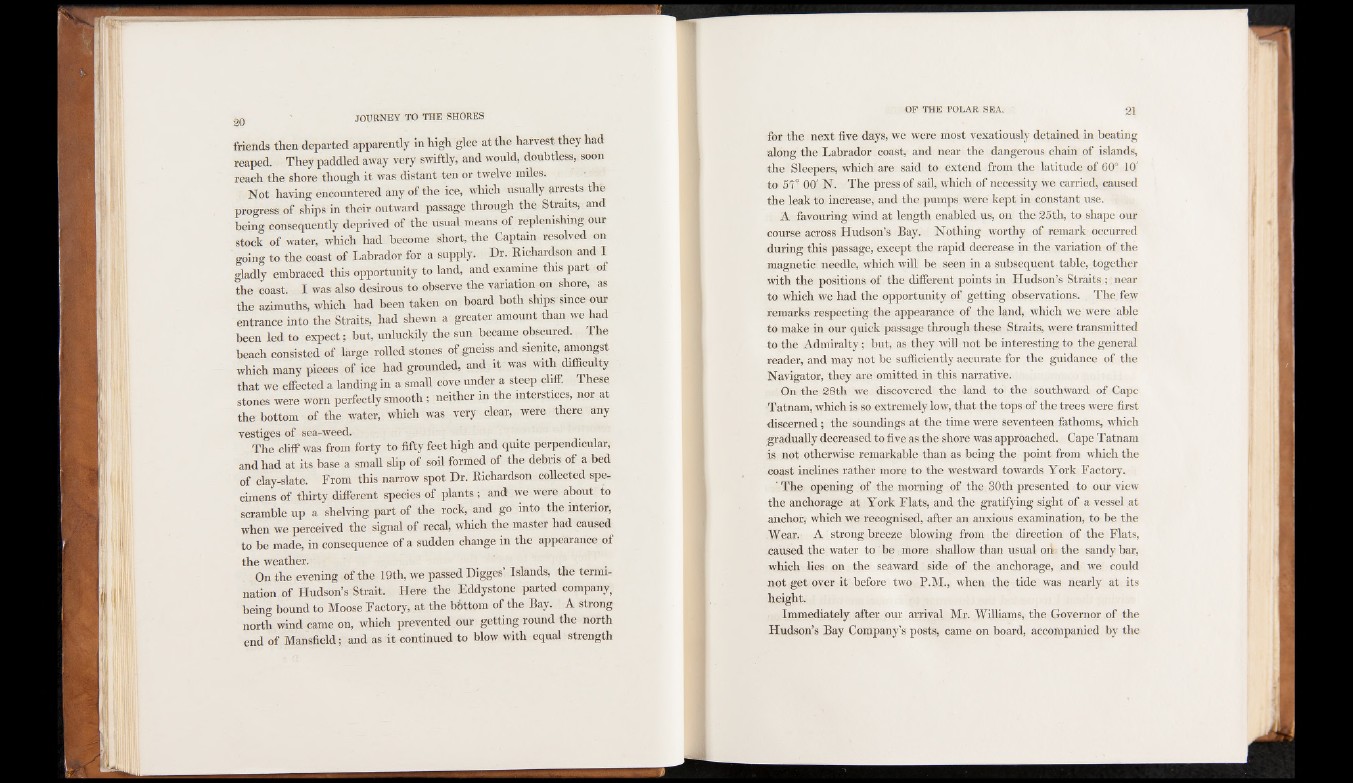
friends then departed apparently in high glee at the harvest they had
reaped. They paddled away very swiftly, and would, doubtless, soon
reach the shore though it was distant ten or twelve miles.
Not having encountered any of the ice, which usually arrests the
progress of ships in their outward passage through the Straits, and
being consequently deprived of the usual means of replenishing our
stock of water, which had become short, the Captain resolved on
going to the coast of Labrador for a supply. Dr. Richardson and I
gladly embraced this opportunity to land, and examine this part of
the coast. I was also desirous to observe the variation on shore, as
the azimuths, which had been taken on board both ships since our
entrance into the Straits, had shewn a greater amount than we had
been led to expect; but, unluckily the sun became obscured. The
beach consisted of large rolled stones of gneiss and sienite, amongst
which many pieces of ice had grounded, and it was with difficulty
that we effected a landing in a small cove under a steep cliff. These
stones were worn perfectly smooth ; neither in the interstices, nor at
the bottom of the water, which was very clear, were there any
vestiges of sea-weed.
The cliff was from forty to fifty feet high and quite perpendicular,
and had at its base a small slip of soil formed of the debris of a bed
of clay-slate. From this narrow spot Dr. Richardson collected specimens
of thirty different species of plants ; and we were about to
scramble up a shelving part of the rock, and go into the interior,
when we perceived the signal of recal, which the master had caused
to be made, in consequence of a sudden change in the appearance of
the weather.
On the evening of the 19th, we passed Digges Islands, the termination
of Hudson’s Strait. Here the Eddystone parted company,
being bound to Moose Factory, at the bfittom of the Bay. A strong
north wind came on, which prevented our getting round the north
end of Mansfield; and as it continued to blow with equal strength
for the next five days, we were most vexatiously detained in beating
along the Labrador coast, and near the dangerous chain of islands,
the Sleepers, which are said to extend from the latitude of 60° IQ'
to 57° 00' N. The press of sail, which of necessity we carried, caused
the leak to increase, and the pumps were kept in constant use.
A favouring wind at length enabled us, on the 25th, to shape our
course across Hudson’s Bay. Nothing worthy of remark occurred
during this passage, except the rapid decrease in the variation of the
magnetic needle, which will be seen in a subsequent table, together
with the positions of the different points in Hudson’s Straits ; near
to which we had the opportunity of getting observations. The few
remarks respecting the appearance of the land, which we were able
to make in our quick passage through these Straits, were transmitted
to the Admiralty; but, as they will not be interesting to the general
reader, and may not be sufficiently accurate for the guidance of the
Navigator, they are omitted in this narrative.
On the 28th we discovered the land to the southward of Cape
Tatnam, which is so extremely low, that the tops of the trees were first
discerned; the soundings at the time were seventeen fathoms, which
gradually decreased to five as the shore was approached. Cape Tatnam
is not otherwise remarkable than as being the point from which the
coast inclines rather more to the westward towards York Factory.
' The opening of the morning of the 30th presented to our view
the anchorage at York Flats, and the gratifying sight of a vessel at
anchor, which we recognised, after an anxious examination, to be the
Wear. A strong breeze blowing from the direction of the Flats,
caused the water to be more shallow than usual oil the sandy bar,
which lies on the seaward side of the anchorage, and we could
not get over it before two P.M., when the tide was nearly at its
height.
Immediately after our arrival Mr. Williams, the Governor of the
Hudson’s Bay Company's posts, came on board, accompanied by the